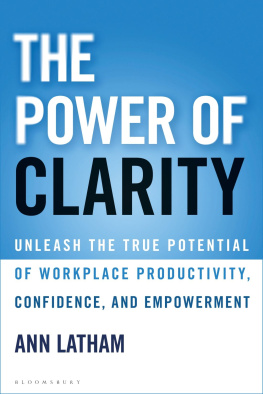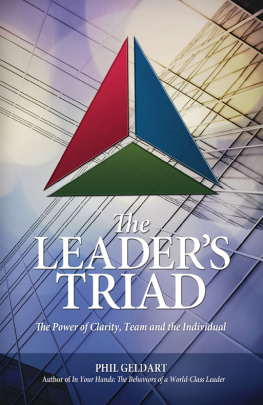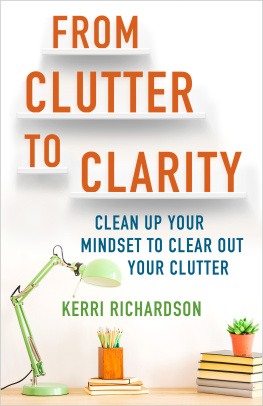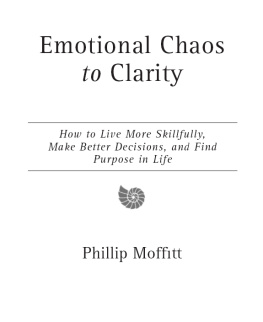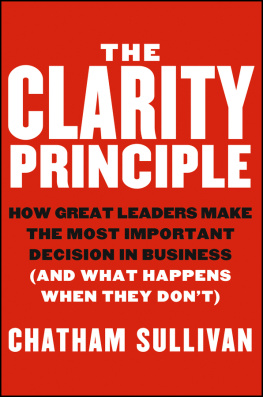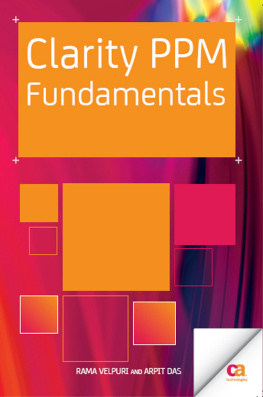THE CLARITY PAPERS
The Executives Guide to Clear Thinking and Better,
Faster Results
Ann Latham

Red Oak Hill Press, January 2018
THE CLARITY PAPERS
Copyright 2018 by Ann Latham
All rights reserved under International and Pan-American Copyright Conventions. Published in the United States of America by Red Oak Hill Press. No part of this book may be used or reproduced in any manner whatsoever without written permission from info@RedOakHillPress.com.
This ebook is licensed for your personal enjoyment only. This ebook may not be re-sold or given away to other people. If you would like to share this book with another person, please purchase an additional copy for each recipient. If youre reading this book and did not purchase it, or it was not purchased for your use only, then please return to your favorite ebook retailer and purchase your own copy. Thank you for respecting the hard work of this author.
F irst, I would not be a successful consultant without the support of my coach and mentor Alan Weiss, the brilliant rock star of consulting. I never even would have had the guts to quit my job without Alan. Being a part of his global community of amazing consultants has also been a source of tremendous growth and inspiration for me. I am particularly grateful for two colleagues, Dr. Andy Bass of Bass Clusker Consulting in Birmingham, England and Roberta Matuson of Matuson Consulting in Boston who have enthusiastically provided me with encouragement, great ideas, and advice for more than a decade.
I am also grateful for all my clients. I appreciate their loyalty, their honesty, and, of course, their referrals! One of the great things about consulting is the learning. I never fail to learn from every client. It would take too much space to thank them all individually for everything theyve taught me and every way theyve supported me, but Id like to single out a few. I want to thank Rod Sitterly, owner of Sitterly Movers in Greenfield, Massachusetts, for being my very first client! If he reads this, I hope he smiles at the news! Id also like to thank Perry Walraven, CEO of PCI, Inc. in Philadelphia, for his on-going business, support, and mutually enlightening conversations about business and life. Last, but not least, Id like to thank Ed Gerding, VP at Boeing in St. Louis, for believing in me and the value of clarity long before others at Boeing finally caught on. To all the rest of you, I give my heartfelt thanks as well!
While I wouldnt be a consultant without those mentioned above and many others, this book would not be a book without Debs Jenkins, my endlessly enthusiastic, decisive, and perceptive editor from Spain.
And Id be neither a consultant, nor an author, without my husband Rick. His unwavering faith in my abilities, encouragement, patience, and selfless willingness to keep the house functioning, the meals coming, and the wine cellar stocked while Im immersed in work or traveling have been of immeasurable value to me. I could never thank him enough.
Other Books by Ann Latham
C lear Thoughts Pragmatic Gems of Better Business Thinking (volume 1)
Clear Thoughts Volume 2 Pragmatic Gems of Better Business Thinking (volume 2)
Uncommon Meetings 7 Quick Tips for Better Results in Half the Time
Dedicated to my parents from whom I undoubtedly inherited my clarity, but whose clarity I did not fully recognize or appreciate until their deaths.
M ost well-run organizations understand the importance of goals, clear roles and responsibilities, and alignment. They establish strategic priorities and annual goals. They develop job descriptions, policies, rules, and training programs. They create well-defined and documented production processes. They also establish well-defined management systems that control things like performance reviews, budgeting, approval processes, and projects. All told, these constitute a yeoman's effort to create the three dimensions of clarity needed for productive, effective, committed employees:
- Clear purpose,
- Clear roles, and
- Clear process.
The resulting structure and controls are essential for allowing growing and shifting numbers of people to work together effectively.
But there's a problem with this: It doesn't help employees get through their average work day.
Why employees still lack clarity of purpose
Those annual goals, even if individualized and broken down by quarter, don't help people establish goals for the next hour, the next conversation, the next email, or the next meeting. Those annual goals don't help people figure out what to do when their priority list has gotten so long that they have no priorities. Those annual goals don't help much when priorities shift or projects fail. No, these top-down efforts to create clarity simply do not create the clarity of purpose employees need to be efficient and effective on a weekly, daily, and hourly basis. Furthermore, they simply cant. It isnt possible to create clarity in the moment from the top down.
Why employees still lack clarity of roles
Job descriptions and employee handbooks don't create sufficient clarity of roles either. Job descriptions have limited value when you are in the trenches. Actual roles vary with each request, each relationship, and availability. While you might be willing to leave the details of a project to Dean because he's a detail guy, you know you would be crazy to ask the same of Paul, who is never to be trusted with methodical, detailed tasks. And when Sarah is suddenly shipped off to troubleshoot at a customer site, you have no choice but to fill the gap yourself or find a substitute. Top-down efforts to predefine roles may make management feel as if everything is under control, but they can't possibly create the clarity of roles that employees need to deal with daily reality.
Why employees still lack clarity of process
The same can be said about clarity of process. Clear processes create efficiencies. But efforts to establish well-defined processes are generally limited to two types of processes: production processes and management system processes. Those processes don't help employees get through meetings or make decisions. They don't help employees solve messy problems. As a matter of fact, unless your work is closely tied to the production line, you may not even think of your work in terms of processes. This is especially true of knowledge workers and managers. No, top-down efforts do not create the kind of clarity of process that makes for efficient, highly-productive employees. And it can't! Top-down controls leave huge gaps.
Next page

